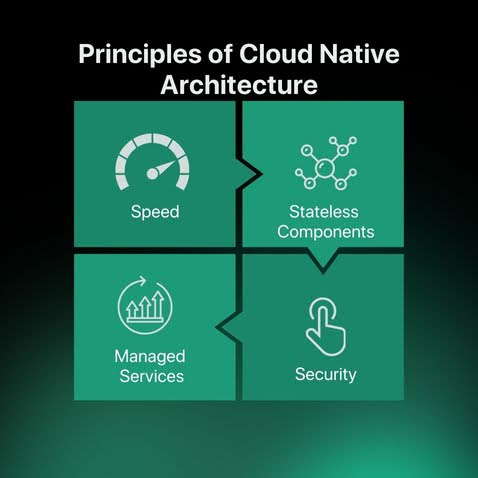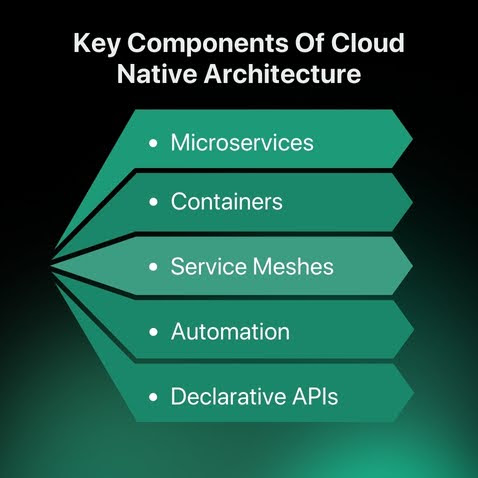Did you know? Over 85% of companies worldwide are projected to be cloud-first by 2025.
There’s an ongoing rise of cloud infrastructure and how it is taking over most software development. Businesses now demand applications that are scalable, resilient, and adaptable.
Cloud native architecture is the result of this demand, a scalable architecture solution that aids in building and running modern applications. Let’s examine the core components of cloud native architecture.
First, we’ll start with what cloud native architecture is.
What Is Cloud Native Architecture?
Cloud native architecture constructs applications as collections of small, independent services. These services are containerized and managed dynamically.
Cloud native allows organizations to develop and deploy applications rapidly and reliably at scale. Cloud native architecture is now so popular that it now has a framework established by the Cloud Native Computing Foundation in 2015, an organization behind many popular solutions like Kubernetes and Crossplane.
Know this too: SquareOps has certification in DevOps and Kubernetes, two vital parts of cloud native architecture. Read more about our certifications here.
Principles of Cloud Native Architecture

Several guiding principles underpin cloud-native architecture:
- Speed: Cloud native architectures prioritize speed through efficient resource utilization, enabling rapid development. This focus on speed allows businesses to quickly respond to market changes and deliver value to users faster.
- Stateless Components: Services avoid storing state internally. Instead, they rely on external data stores. This simplifies scaling and recovery, as any instance of a service can handle any request.
- Managed Services: Cloud native architectures often use managed services offered by cloud providers. These services handle operational tasks like database management and message queuing, reducing operational overhead.
- Security: Cloud native architectures implement the zero-trust model, assuming no implicit trust. They use defense-in-depth strategies, adding multiple layers of security.
Now, let’s dive into the components of cloud-native architecture that make these principles come to life.
Key Components Of Cloud Native Architecture

A few key components make up cloud-native architecture. To sum them up is this list:
- Microservices: These small, independently deployable services each perform a specific business function.
- Containers: These lightweight, portable packages contain the application code, runtime, system tools, system libraries, and settings.
- Service Meshes: These dedicated infrastructure layers manage service-to-service communication.
- Automation: Automation can be enabled at every stage of the application lifecycle, from building and testing to deployment and monitoring.
- Declarative APIs: These interfaces define the desired state of the system.
Let’s go through each of these components in some detail now!
1. Microservices
Microservices represent a significant shift from monolithic application development. Instead of one large, complex application, microservices break down functionality into smaller, independent services. This decomposition brings several advantages:
- Flexibility and Independent Scaling: Teams can develop, deploy, and scale individual services independently. This allows for faster development cycles and efficient resource use.
- Loose Coupling: Microservices communicate through well-defined APIs. This loose coupling means changes to one service have minimal impact on others. This isolation simplifies development and maintenance.
- Focus on Specific Problems: Each microservice addresses a particular business problem. This specialization leads to simpler code and easier understanding.
2. Containers and Orchestration
Containers provide a consistent and portable environment for running microservices. They package the application code and all its dependencies, ensuring consistent behavior across different environments. Container orchestration tools, like Kubernetes, automate the deployment, scaling, and management of these containers. Orchestration systems handle tasks like:
- Scheduling: Placing containers on appropriate nodes within a cluster.
- Scaling: Adjusting the number of running containers based on demand.
- Service Discovery: Locating and connecting services to each other.
- Load Balancing: Distributing traffic across multiple instances of a service.
- Health Monitoring: Checking the status of containers and restarting them if needed.
3. Automation and DevOps
Automation is one component that cloud native architectures largely benefit from. DevOps practices, which emphasize collaboration and automation between development and operations teams, are essential for achieving agility and speed. Key aspects of automation and DevOps include:
- Continuous Integration/Continuous Delivery: CI/CD pipelines automate the building, testing, and deployment of applications. This enables frequent and reliable releases.
- Infrastructure as Code (IaC): IaC treats infrastructure as code, allowing for automated provisioning and management of resources. This increases consistency and reduces errors.
- Automated Testing: Automated tests occur at various stages of the development process, ensuring code quality and reducing the risk of regressions.
Not convinced yet? Let’s take a look at some of the amazing benefits that cloud-native architecture can provide for your operations.
Benefits of Cloud Native Architecture
Adopting a cloud-native approach brings multiple benefits:
- Scalability and Agility: Applications can scale quickly to meet changing demands. This allows businesses to adapt to market conditions and user growth.
- Cost Efficiency: Optimized resource use and reduced operational overhead lead to cost savings. Pay-as-you-go cloud models further enhance cost efficiency.
- Enhanced Developer Productivity: Modularity and faster testing processes improve developer productivity. Independent deployments allow teams to work concurrently.
- Improved Resilience: Microservices architecture combined with container orchestration creates more resilient applications. If one service fails, others can continue to operate.
- Faster Time to Market: Agile development practices and automated deployments reduce the time it takes to release new features and applications.
It’s also important to understand that not all solutions are perfect, so let’s take a look at what challenges cloud native architectures come with.
Challenges With Cloud Native Architecture
While cloud-native architecture offers significant advantages, it also presents certain challenges:
- Complexity: Managing many interacting services can be complicated.
For instance, SquareOps helped a client with their microservices architecture by implementing robust monitoring tools and clear communication protocols to manage the complexity and ensure smooth operations.
- Monitoring and Observability: With so many moving parts in a microservices environment, tracking performance and metrics can be tricky. Tools like distributed tracing are essential.
- Security: Securing a distributed system is key. This includes using zero-trust principles, secure communication, and strong access control.
- Operational Overhead: While cloud services reduce some management effort, a cloud-native setup still requires expertise. Automating key processes and providing training ensures operations run smoothly without getting bogged down.
To help you avoid these challenges in adopting cloud-native architecture, we recommend you talk to SquareOps, leaders in cloud development and migrating on-premises infrastructure to the cloud.
Just take a look at our case studies to see how we’ve achieved this!
A Cloud-Ready Solution
Cloud native architecture offers a powerful and effective approach to building and running modern applications. By applying the principles and solutions we’ve outlined in this article, you can achieve greater agility, scalability, and efficiency.
Remember, SquareOps is a leading cloud migration and native architecture expert. Contact us today and we’d be more than happy to accelerate your cloud architecture journey today.
Frequently-asked Questions About Cloud Native Architecture
1. What is a cloud-native architecture?
Cloud-native architecture is a design approach that leverages cloud computing principles, using microservices, containers, and automation to build scalable, flexible, and resilient applications.
2. What are the four types of cloud architecture?
The four types are:
- Public Cloud
- Private Cloud
- Hybrid Cloud
- Multi-Cloud
3. Does a cloud architect require coding?
While coding is not always the primary focus, a cloud architect should have a strong understanding of coding and infrastructure automation to design, implement, and manage cloud solutions.
4. Which country pays the highest salary for cloud architects?
The United States typically offers the highest salary for cloud architects, with top-paying states like California and New York.
5. How to learn cloud architecture?
Learning cloud architecture can be done through online courses (AWS, Google Cloud, Azure), certifications, hands-on practice with cloud platforms, and following industry trends and best practices.
6. What is SLA in cloud computing?
SLA (Service-Level Agreement) is a contract between a cloud service provider and a customer that defines the level of service expected, including uptime, response times, and support availability.
7. What is cloud bursting?
Cloud bursting is a hybrid cloud deployment model where an application runs in a private cloud but “bursts” into a public cloud during high demand to scale up resources.
8. What is the full form of SLO?
SLO stands for Service Level Objective, which defines the target level of service (e.g., uptime, response time) that a provider commits to meet within an SLA.
